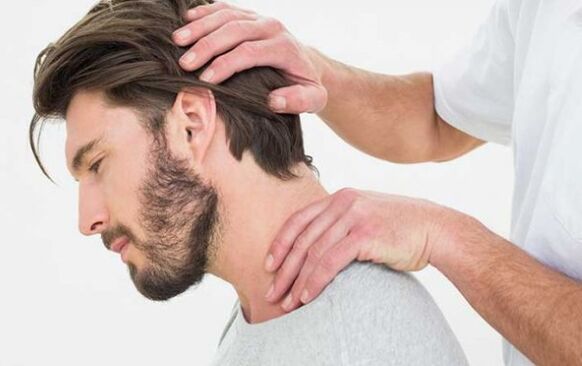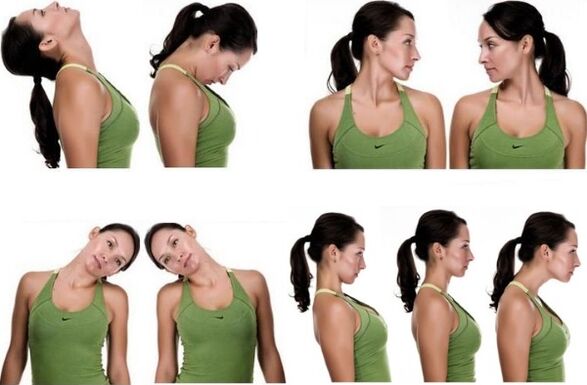What is cervical osteochondrosis
Why is osteochondrosis of the neck dangerous?
Causes of cervical osteochondrosis
- lack of physical activity;
- Unbalanced diet;
- increased formation of urate;
- Metabolic disorders;
- Psycho-emotional stress;
- Sedentary jobs (drivers, computer typists);
- Consequences of acute respiratory infection, ARVI;
- excess weight;
- Axial frame damage;
- spinal hypothermia;
- Endocrine disorders;
- neck load;
- Distorted body posture when resting at night;
- Autoimmune diseases.
Stages of development of osteochondrosis
- The first stage.In the early stages of development of cervical osteochondrosis, the symptoms are mild. A person might not place too much importance on the small painful changes that are occurring in nature. At this stage, the cartilage has not lost its elasticity, but the changes are just beginning.
- second stage.This stage of the disease is characterized by damage to the cartilage tissue of the vertebrae. This process gradually moves to the body's joints, muscles, and vascular system. The pain occurs due to pinched nerves, to which the arm, shoulder and subscapular area (affected side) respond. At this stage of the disease, this is often confused with other pathologies in the body.
- The third phase.This stage of the pathological process is characterized by disc destruction without annular rupture and should be termed herniation.
- The fourth stage.At this stage, surgery is inevitable - a very long process: the disc is displaced, compressing the spinal canal - disc herniation. The manifestation of 2 mm displacement is threatening human life.
symptom
- neck pain;
- Abnormal sensation on the injured side (numbness of the hand);
- fatigue;
- bow down.
- soreness in the affected area;
- Numbness in the collar area (passing);
- Migraine (due to vasospasm);
- hypertension;
- reduced physical activity;
- bow down;
- Pain in the back, shoulder blades and arms (from pathological processes);
- Chest pain.
- The appearance of a herniation (herniation of the annulus fibrosus into the spinal canal);
- Severe pain radiating to shoulders and arms;
- Numbness in the neck.
- Neck curvature;
- The neck muscles lose their ability to support the head;
- Abnormal sensation in neck and head muscles;
- Severe pain in the arms and collar area;
- numbness of tongue;
- Insomnia.
In the fourth stage, the neurologist recommends surgical intervention.
Syndromes caused by cervical osteochondrosis
- hearing loss;
- Vertebral artery disease.
- C2– Pain in the back of the head, weakness of the mylohyoid muscle;
- C3– Congested tongue, slurred speech, incomplete paralysis of the mandibular muscles, and numbness of the neck;
- C4– Clavicle muscle pain and weakness, breathing problems, unexplained pain in the hepatobiliary system, numbness in the neck and collar area;
- C5– The syndrome is characterized by shoulder numbness, weakness, and loss of superficial shoulder muscle volume;
- C6 –The main pathological manifestations are neck to shoulder pain and thumb numbness;
- C7– Characterized by pain in the neck below the shoulder blades, numbness of the index and middle fingers (on the injured side);
- C8– Pain from the neck to the elbow and little finger, paresthesia in the shoulder, scapula and affected fingers.
- pain:Neck pain (morning); pain in neck and occipital area; sore neck, persistent pain in shoulders;
- Muscle Supplements: Muscle tension; persistent pain in the back of the head; soreness in the subscapular area; spasm in the neck and collar area; shoulder joint deformity; shoulder muscle atrophy.
- The consequence of mechanical damage is the narrowing of arterial vessels;
- organic impairment of brain activity;
- Migraine;
- Rotating pain in the back of the head;
- Neuropathic cutaneous pain in head;
- hearing loss;
- Unsteady gait;
- the feeling of wave visibility;
- Faint state.
- pain and numbness in the extremities;
- Sensitivity disorders;
- Minor disorders of the pelvic organs;
- Facial numbness.
- Shocking;
- intracranial hypertension;
- Disturbances in psychological and emotional balance;
- Pain in the parietal and occipital regions of the head;
- gag reflex;
- Optic nerve pallor;
- Dizziness;
- Oculomotor reflex disorder;
- weak;
- Depressive state.
diagnosis
- Computed tomography of the neck;
- Magnetic resonance imaging of damaged areas;
- Vascular SCT;
- Several projections of spine X-rays;
- Visit an ophthalmologist to measure intraocular pressure;
- Vascular Doppler Ultrasound;
- Hand ENMG;
- clinical blood tests;
- ESR detailed analysis.
Treatment of cervical osteochondrosis

- Antispasmodics;
- painkiller;
- NSAIDs – non-steroidal anti-inflammatory drugs;
- Preparations containing collagen - for the repair of cartilage tissue;
- Vitamin therapy with group B drugs.
- pain relief ointments;
- Dressings to relieve inflammation;
- chondroprotectant;
- Ointment with a warming effect.
- Therapeutic and recreational massage of the neck and collar area;
- Reflexology;
- exercise therapy;
- Use a special orthopedic neck brace.
- For sensitivity disorders;
- Accompanied by large segmental stenosis of the spinal canal.
First aid for severe pain
- Observe strict bed rest;
- Use antispasmodics and analgesics;
- Immobilize the neck with a special brace or collar;
- You should also wrap a warm scarf around your neck;
- For swelling, diuretics should be administered;
- Topical anesthetic ointments;
- use muscle relaxants;
- Use sedatives.
All medications listed should be prescribed by a neurologist.
medical treatement
NSAIDs
muscle relaxants
Hormone drugs
paravertebral block
Using this method, severe pain is quickly relieved, congestion disappears, and local metabolism is improved.
ointment
chondroprotectant
Homeopathy
Drugs to treat dizziness in osteochondrosis
- Nootropics– Improves microcirculation, calms the nervous system and improves the relationship between the cerebral hemispheres.
- Medications used to treat vestibular disorders.They have the activity of dilating blood vessels in the brain, thus improving blood circulation.
- intravenous refills– These products improve the tone of the vascular system and blood circulation.
vitamins and minerals
Schantz's collar

needle applicator

physiotherapy
manual therapy

Blood circulation returns to normal and swelling disappears.
acupuncture
Exercise therapy for cervical osteochondrosis
- basic position– Stand with your back straight and your face looking forward. It is necessary to carefully turn your head to the right (without tilting it backward or forward) to the level of your shoulders and stabilize your body. After a few seconds, return to the previous position. The same thing should be done on the other side. There should be no pain.
- initial position– Keep your back straight and face forward. You should gently stretch your body, tilt your head, and place your right ear on your shoulder. You need to imagine your left ear stretching upwards and try to do this. Maintain this position for a few seconds. Return to starting position. Do the exercise on the second side.
- Stand up straight, you need to face down looking at your legs and lower your torso– Vertebra by vertebra – towards the floor. For the untrained eye, you need to grab your knees, back straight parallel to the floor, and face forward. This exercise works the entire spine, especially the neck. Stay longer. Relax your head and torso downward. Slowly, without hurrying to avoid dizziness, return to the original position, vertebra by vertebra.
- Stand up straight, or you can sit in a chair with a straight back.Without rounding your back, you should lower your chin to your chest and extend the back of your head upward—like stretching your vertebrae. Hold this position for a few seconds, slowly relax and straighten your neck.
- Rotational movements of the neck and head.With your back straight, you can sit in a chair. Lower your head with your right ear close to your shoulder. From this position, move smoothly and slowly across your chest to your opposite (left) shoulder and back. Clean up and tidy up.

Folk remedies treatment
- Tea made from a healthy herb (yarrow).You should take a little dry medicine, pour it into a cup, and then pour boiling water. Make tea and drink after meals. It is great for relieving inflammation and calming the nervous system.
- A medicinal drink made from burdock.Take a small amount of dry herbs and pour into a 500ml thermos, then pour in boiling water. persist in. The amount of medicine obtained should be consumed on one day and should not be left until the next day. You need to drink water between meals. Has analgesic effect.
- Compresses made from plants.You should take equal amounts of chamomile, salvia, wintergreen - these herbs should be dried and ground. Pour boiling water over it. persist in. Moisten a cotton cloth with the resulting solution and apply it to the sore areas of your neck. Cover with film and wrap in a scarf. Leave overnight. Helps relieve inflammation.
- Apple cider vinegar.This is a very healthy natural liquid obtained from apples through a microbial process. It contains a large number of useful substances. You should dilute equal parts vinegar with water. Moisten gauze with the resulting liquid and apply it to the cervical spine, covering it with polyethylene and a scarf overnight. It helps restore cartilage tissue and relieve inflammation.
In order to strengthen your body and replenish your body with useful substances, you should drink apple therapy. You need to add 10 grams of water and drink it before meals.
Therapeutic massage and self-massage
Self-massage includes gentle, caressing and rubbing movements of the neck area.
Surgery
Nutritional characteristics
What is not recommended?
- eating lots of salt and salty foods;
- Do weight lifting and aerobics;
- Women should avoid wearing narrow shoes with high heels;
- Eating too much food, which will definitely lead to weight gain and disruption of metabolic processes;
- Sleeping on a soft bed is unacceptable;
- Sudden movement of the neck can cause a tightening sensation, even if it appears to bring relief.
prevention
- Visit to a steam room (with permission from a neurologist or in the absence of high blood pressure);
- Get regular therapeutic massage;
- If the disorder is present and has been treated, receive treatment according to the recommendations of your neurologist;
- go swimming;
- Yoga gymnastics is the main type of therapeutic and preventive physical activity;
- Balanced diet;
- Get rid of bad habits - alcohol and nicotine, which disrupt metabolic processes in the body.



















